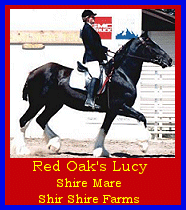Origin: Britain
 | Color: Black, bay, or gray, with characteristic white markings and heavy feather on the legs. Avg Height: 16.2 to 17.2 hh Avg Weight: 2,200 to 2,700 lbs |
Build: The Shire has a medium-sized head, which is broad between the large, prominent eyes and is usually slightly Roman-nosed. Its neck is relatively long and slightly arched; its shoulders are deep and oblique, and its body is broad and muscular.
Temperament: An immensely strong, yet very docile animal.
Main use: Still used in remote areas for agricultural work, but mostly used for harness, show, and pleasure. In cities it has proved to be more economical than motor transport for short haulage, especially by breweries.
Special abilities: The Shire Horse is considered to be the ultimate draft horse.
History: The name "Shire" comes from England, and derives its name from the Saxon word "schyran," which means to shear or divide, hence the name "Shire," that is synonymous with county. King Henry VIII first applied the name "Shire" to the horse early in the 16th century. Said to have descended directly from the medieval warhorse known as the Great Horse, the Shire is the largest both in height and in weight of the British heavy draft breeds. It is also reputedly the largest purebred horse in the world. In Britain the principal breeding areas are Cambridgeshire, Huntingdonshire, and Lincolnshire. The breed is also established in a number of other countries, including the US. Although the first Shire was imported to America in 1853, substantial importation did not begin until after the 1880's. As the new century began, the Shire seemed poised to challenge the Percheron as the nation's most popular draft horse. From 1909 through 1911 around 6,700 Shires were registered. Because of their large size and flashy action, the Shire had been particularly popular in the urban America. By the end of World War I, however, the draft horse had virtually been replaced by the truck, subway, and electric streetcar in the city. At the same time, farmers were looking for a smaller, more economical horse to work the fields. Belgians and Percherons came to dominate the Midwest draft horse market causing the center of Shire breeding to moved to the West. Their numbers continued to drop throughout the 1940s and 50s, with only twenty-five horses registered from 1950 through 1959. Today the Shire, like most draft breeds, is making a comeback. By 1985 there were 121 Shires registered in America.

For Breeders, Farms, and Studs of this breed, click here.
If you have a horse of this breed, and you would like to see your pictures posted here, or if you would like to advertise your business that involves this particular breed, you can also email me.
I'm not perfect, and I never claim to be! If you see anything here that you believe I am wrong about, please feel free to email me. I might not agree with you, but at least I will listen!! :0) Can you fill in any of my blanks? Do you know of information or links that you would like to share with draft animal enthusiasts that you don't see here? Am I missing anything? Let me know at Draftladyb@yahoo.com.